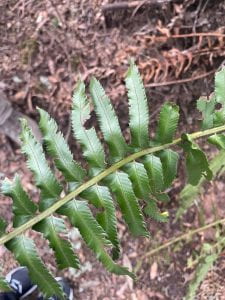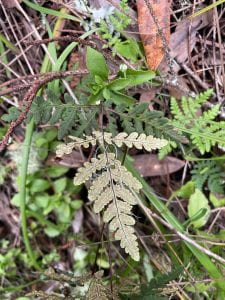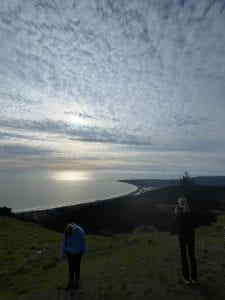Location + Site Description:
Mt. Tamalpais to Laurel Dell trailhead’s geographic coordinates are: 37.923435°N, 122.627502°W. The elevation of the mountain is about 2,572 feet which is surrounded by oak woodlands with lots of coastal shrubs. We saw a great amount of different ferns from different families, along with Fagaceaes and Ericaceaes. Dominant species included many fern variations such as chain ferns, western sword fern, coffee fern, and etc. The trail we walked was called the Laurel Dell trailhead where we hiked down along Cataract Creek. This walk was about 2 miles roundtrip, which is mostly downhill. The hike offers a breathtaking view of Stinson beach, along the coast! We even got to see an “instagram-worthy” waterfall which streams down the creek.
Species descriptions and digital collections:
1. Tanoak (Notholithocarpus densiflorus)


This Notholithocarpus densiflorus is commonly known as the tanoak from the family Fagaceae; found about 31 meters from the start site. This is one of the bigger tanoaks we seen on the trail, which can grow from 15-40 meters in height. This particular tanoak has these white spotted leaves which are partially due to a disease (not quite sure what disease). They tend to grow in the California coast ranges in a canopy-like area. Its leaves are simple alternate, 3-5 inches, with toothed margins and a hard, leathery texture. They also grow seeds (acorn) which is smilier to an oak acorn, but with a very hard, woody nut shell.
2. Western sword fern (Polystichum munitum)



This Polystichum munitum is commonly known as the western sword fern from the family Dryopteridaceae. They grow under redwood forests or duhfur forests, but mostly at low elevations. The leaves are single-pinnate, with the pinnae alternating on the stalk. This fern is termed “western sword fern” due to the leaves that are in the shape as a sword–wide at the base where it gets skinner at the top. Each individual leaf are quite spiky, much like bristles on the edges. However, when turned over, the leaves produce light yellow spores where the sori sits on two rows on either side of the midrib of each pinna. Usually these sori have this umbrella-like cover called the indium, but it was pretty hard to see due to the size of the sori.
3. Gold back fern (Pentagramma triangularis)


This fern Pentagramma triangularis is commonly known as the goldback fern from the family Pteridaceae. It’s called “goldback” because it refers to the light yellow (gold) color of the ferns protective coating when it is flipped over. It is visibly seen that its overall shape is a triangle which can grow to a height of 6 to 12 inches. These ferns commonly grows along cliffs and wet areas. The stems are very hard to touch where is kind of feel like plastic!
Narrative:
We left the USF campus at around 1pm and got back at exactly 5pm PST. The weather started to get sunny, but it was super windy and cold. Majority of the walk was downhill where we crossed creeks and many rocks on the floor, even spotted fallen trees on the way! It took us about 1 hour downhill, at a slow pace to learn and observe the many plants around us. We ended at a beautiful waterfall that was really steep to get to. Majority of the nice ferns were more visible the lower the elevation, closer to wet and moist areas. Going back up, it was tough because of the different inclines we reached, I think this was the reason for it being pretty quiet on the walk back (haha). Once we got back, everyone was pretty winded from the hike back up, but it was worth it to see the breathtaking view of the coast! Overall, this first field trip was beautiful, to say the least. It’s great getting away from the city and get a breather in nature. Pictures featuring the one and only Professor Paul with his favorite ferns!




